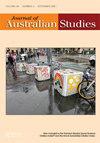澳大利亚画报杂志的历史
IF 0.4
3区 历史学
Q3 AREA STUDIES
引用次数: 0
摘要
就像今天的互联网一样,这本插图杂志在20世纪的大部分时间里显著地定义了澳大利亚读者对国家和世界的了解。杂志为家庭空间和牙医诊所增色不少;杂志摊挤满了繁忙的城市街角和交通枢纽;出版商、政府部门和旅游局向海外发送杂志,以吸引移民、商业投资和游客。到1961年,多达80万澳大利亚人阅读《澳大利亚妇女周刊》,在1963年包括900种期刊和杂志的商业市场上,许多其他刊物也定期取得了很大的发行量。该周刊继续为学术研究提供新的途径,从教育到艺术史到冷战政治,以及食品和时尚史。《澳大利亚研究杂志》的主题部分是一个研究项目的一部分,该项目旨在使澳大利亚的杂志研究多样化,拓宽杂志在澳大利亚文化史上的重要性的来源和理解,并将跨学科的学术研究与新的国际发展联系起来。最优秀、最聪明的人才为现代杂志做出了贡献(除了报纸和广播之外,还经常跨媒体平台)。作家和旅行家,如乔治·法威尔、欧内斯汀·希尔和伊恩·伊德里斯,以资助其他创意项目为生,而包括唐纳德·汤姆森和厄休拉·麦康奈尔在内的人类学家则利用杂志向公众传播他们与土著社区的研究成果。原住民社区自己使用通讯来建立联系,20世纪70年代出现的《身份》(Identity)等杂志打造了一个新的土著公共领域。科学家和博物学家,如查尔斯·巴雷特,塔尔顿·雷门特和本文章由计算机程序翻译,如有差异,请以英文原文为准。
Histories of the Illustrated Magazine in Australia
As the Internet does today, the illustrated magazine significantly defined Australian readers’ knowledge of the nation and the world for much of the 20th century. Magazines graced domestic spaces and dentists’ surgeries; magazine stands filled busy city street corners and transport hubs; and publishers, government departments, and tourism bureaus sent magazines overseas to attract migrants, business investments and tourists. Up to 800,000 Australians read theAustralianWomen’s Weekly by 1961, with many other titles regularly achieving large circulation figures in a commercial market that in 1963 included 900 journals and magazines. The Weekly continues to provide new avenues for scholarly research, from education to art history to Cold War politics, as well as food and fashion histories. Our themed section for the Journal of Australian Studies forms part of a research project designed to diversify magazine studies in Australia, to broaden the sources and understanding of their significance in Australian cultural history, and to connect scholarship across disciplines and link it to new international developments. The best and brightest minds contributed to modern magazines (alongside newspapers and radio, and often across media platforms). Writers and travellers such as George Farwell, Ernestine Hill and Ion Idriess earnt a living that underwrote other creative projects, while anthropologists including Donald Thomson and Ursula McConnell used magazines to communicate their work with Indigenous communities to the public. First Nations communities themselves used newsletters to build connections, and magazine titles such as Identity emerged in the 1970s to forge a new Indigenous public sphere. Scientists and naturalists such as Charles Barrett, Tarlton Rayment and
求助全文
通过发布文献求助,成功后即可免费获取论文全文。
去求助
来源期刊

Journal of Australian Studies
Multiple-
CiteScore
0.90
自引率
20.00%
发文量
56
期刊介绍:
The Journal of Australian Studies (JAS) is the journal of the International Australian Studies Association (InASA). In print since the mid-1970s, in the last few decades JAS has been involved in some of the most important discussion about the past, present and future of Australia. The Journal of Australian Studies is a fully refereed, international quarterly journal which publishes scholarly articles and reviews on Australian culture, society, politics, history and literature. The editorial practice is to promote and include multi- and interdisciplinary work.
 求助内容:
求助内容: 应助结果提醒方式:
应助结果提醒方式:


